The better informed we are as parents, the better we will be able to help our children develop their languages and become fully bilingual. Ordered from more practical to more theoretical ones, these 10 books feature an array of valuable insights, discussions, and (research-based) knowledge around the topic of child bilingualism. Take a look!
Be bilingual—Practical ideas for multilingual families (Bourgogne)
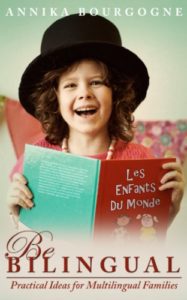 Be bilingual—Practical ideas for multilingual families is the product of a master’s thesis that Annika Bourgogne wrote at the University of Helsinki. It provides a basic introduction to bilingualism which is good for readers who are new to the topic.
Be bilingual—Practical ideas for multilingual families is the product of a master’s thesis that Annika Bourgogne wrote at the University of Helsinki. It provides a basic introduction to bilingualism which is good for readers who are new to the topic.
The book begins with a very brief definition of bilingualism, followed by a review of common myths and approaches to bilingual parenting. The second part is dedicated to more practical ideas for different family situations (e.g., OPOL, mL@H). Bourgogne approaches each topic from two angles: (1) “Words from the wise” and (2) “Views from the front lines”. In “Words from the wise”, she summarizes opinions from experts. However, she does not reference research, publications, or experts very much. In “Views from the front lines”, she shares her own experiences. Overall, the book does not go into detail about bilingualism. It provides more of a light read on the topic.
However, a big plus of this book: It contains practical ideas for different people who raise children with multiple languages (e.g., a single parent, a parent who does not speak the minority language of the spouse, OPOL families etc.). Bourgogne also provides many websites and links (although some are outdated) that point you to additional resources, including books, international radio stations, TV options, computer games, summer camps, and travel opportunities.
Overall, it’s a good read for beginners on the topic of bilingualism and those that seek practical tips, ideas, and resources.
Maximize your child’s bilingual ability (Beck)
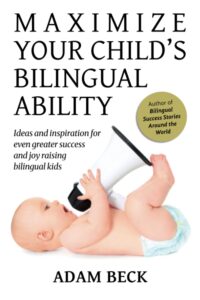 Maximize your child’s bilingual ability by Adam Beck is a best seller among parents who raise children with multiple languages. The book is written in a very accessible English and is based on Beck’s experiences as a father of two bilingual (Japanese and English) children.
Maximize your child’s bilingual ability by Adam Beck is a best seller among parents who raise children with multiple languages. The book is written in a very accessible English and is based on Beck’s experiences as a father of two bilingual (Japanese and English) children.
The book is split into two sections: perspectives and principles. In the first section, Beck shares 30 perspectives or ‘ways of thinking’ about the bilingual journey. He invites parents and teachers to reflect on their opinions and viewpoints with regard to raising bilingual children. In the second part of the book, Beck then translates the ‘ways of thinking’ into 30 action items or “principles” such as “Read Aloud Every Day” or “Play Games Together.” Throughout the second part of the book, Beck offers great, practical ideas for the day-to-day life with multiple languages.
Overall, Maximize your child’s bilingual ability provides a number of practical and hands-on approaches, tips, and strategies. Beck’s style of writing is very entertaining and full of anecdotes that will help you reflect on your own situation.
Raising a bilingual child (Pearson)
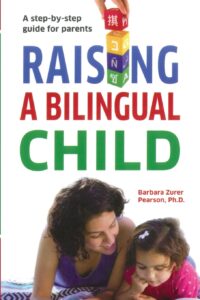 Raising a bilingual child is written by Barbara Zurer Pearson, a scholar in the field of bilingualism and bilingual eduction. This book is densely packed with knowledge about bilingualism.
Raising a bilingual child is written by Barbara Zurer Pearson, a scholar in the field of bilingualism and bilingual eduction. This book is densely packed with knowledge about bilingualism.
The book starts with a chapter about the benefits of childhood bilingualism. The second chapter provides a more psychological perspective, sketching how languages develop in a child. The following chapters deal with topics such as how to establish an effective bilingual environment at home. Many chapters discuss questions that parents may have, including Are children better language learners? or What’s better?: Two languages from birth or second language second? A very nice feature of the book: in almost every chapter, Pearson provides tables that summarize the main points.
Overall, Raising a bilingual child provides a very comprehensive look at the topic of bilingualism. It includes several academic terms and is written in a very dense way. So it may strike you as a bit academic. But it is very informative if you are looking for more than an introduction to the topic of bilingualism.
The bilingual edge: Why, when, and how to teach your child a second language (King & Mackey)
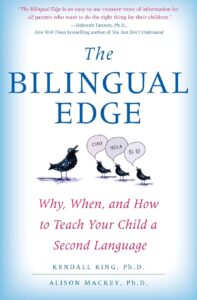 The Bilingual Edge is a great read for parents raising bilingual children. It is well written and thoroughly grounded in research. The authors are well-known scholars in the field of bilingualism and second language learning and they are both moms. So they combine theoretical knowledge and practical experience.
The Bilingual Edge is a great read for parents raising bilingual children. It is well written and thoroughly grounded in research. The authors are well-known scholars in the field of bilingualism and second language learning and they are both moms. So they combine theoretical knowledge and practical experience.
The book deals with the topic of raising bilingual children along four main questions:
- Why are two languages better than one?,
- Which languages and when?,
- How?, and
- What if…?
In the first section, the authors start with unraveling some of the myths and misconceptions about bilingualism. In the second section, they provide useful tips and strategies about how to select and promote multiple languages at home. An interesting angle of this book is that it also takes into account the perspective of ‘additive bilingualism‘. In section three, the authors offer ideas about how to best promote bilingual development. For example, in chapters such as “What makes good edutainment?”, the authors offer advise on how to use entertainment such as TV as an educational resource. In section four, the authors review common issues and challenges, including worries about language delays, special needs, and what to do when your child mixes languages. Across all four sections, the authors highlight practical advice and fast facts.
A particular difference to other books: The Bilingual Edge takes into account the perspective of raising bilingual children in the United States. Overall, it’s an encouraging read that provides entertainment and support. King and Mackey skillfully translate the latest research into action points that can help families regardless of the languages they speak at home.
The bilingual family A handbook for parents
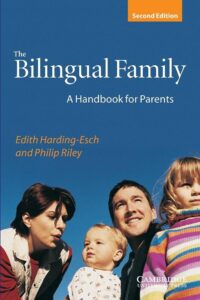 The bilingual family—A handbook for parents is written by Edith Harding-Esch from Cambridge University (UK) and Philip Riley from the University of Nancy (France). So the authors definitely know what they are talking about with regard to the different theoretical aspects of bilingualism. In addition to being experts in the field, they are also parents raising bilingual children themselves.
The bilingual family—A handbook for parents is written by Edith Harding-Esch from Cambridge University (UK) and Philip Riley from the University of Nancy (France). So the authors definitely know what they are talking about with regard to the different theoretical aspects of bilingualism. In addition to being experts in the field, they are also parents raising bilingual children themselves.
The bilingual family is a comprehensive book about the general subject of raising bilingual children. The book starts off with a discussion of ‘children and language’ before diving into the question ‘what is bilingualism?’. Also, it features a number of case studies. Throughout the book Harding-Esch and Riley maintain a focus on bilingualism in children. They do not include bilingualism in adults.
I found the book to be very well written, yet more on the academic side. It provides more of a theoretical approach and knowledge about bilingualism. As such it is a very rich resource of information about bilingualism that will help you as parents better understand certain aspects and challenges.
Overall, it is one of my favorite books on the topic—simply it provide a lot of insights. However, if you are looking for practical tips and resources, then this may not necessarily be the book you are looking for.
A Parents’ and Teachers’ Guide to Bilingualism (Baker)
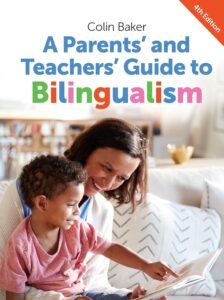 This book which is now available in its fourth edition, is pretty unique. It is completely guided by questions. Colin Baker subdivided the book into six sections. Each section features a bunch of questions that are related to a specific topic. For example, Section A deals with “Family Questions.” It raises and discusses concerns that parents may have such as “My partner does not understand the language that I speak to my child. Is this a problem?” or “What happens if grandparents and the extended family disapprove of bilingualism?”. Then, Second B is about language development. Section C deals with problems that may occur when you raise bilingual children, Section D is about reading and writing. Section E about education and schooling, and Section F deals with general questions such as legal rights to bilingual education, and politics around bilingualism. Throughout the book, Baker answers each question in a concise form with reference to research, testimonials, and experiences. Moreover, he offers further readings for those interested to learn more.
This book which is now available in its fourth edition, is pretty unique. It is completely guided by questions. Colin Baker subdivided the book into six sections. Each section features a bunch of questions that are related to a specific topic. For example, Section A deals with “Family Questions.” It raises and discusses concerns that parents may have such as “My partner does not understand the language that I speak to my child. Is this a problem?” or “What happens if grandparents and the extended family disapprove of bilingualism?”. Then, Second B is about language development. Section C deals with problems that may occur when you raise bilingual children, Section D is about reading and writing. Section E about education and schooling, and Section F deals with general questions such as legal rights to bilingual education, and politics around bilingualism. Throughout the book, Baker answers each question in a concise form with reference to research, testimonials, and experiences. Moreover, he offers further readings for those interested to learn more.
Overall, this book is written in an easy-to-follow style and discusses questions that I have heard from several parents. As such, it is highly recommendable for both parents who are considering raising their children bilingually and those who already do so.
An Introduction to Bilingual Development (de Houwer)
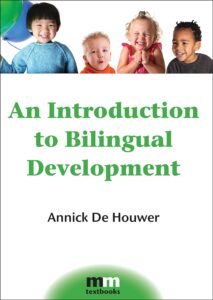 This book is technically an introductory textbook. However, it is interesting insofar as it focuses in more detail on children’s language development. More specifically, it focuses on what is called “bilingual first language acquisition” or how children come to understand and speak multiple languages. It provides insights into the bilingual development of four children with different language profiles. Drawing upon research, Houwer explains the bilingual development in each child, thus showing how the children acquire sounds, words, and sentences and are able to use each of their languages in socially appropriate ways. She also highlights important aspects such as parents’ and caregivers’ positive attitudes towards bilingualism, that help children become bilingual.
This book is technically an introductory textbook. However, it is interesting insofar as it focuses in more detail on children’s language development. More specifically, it focuses on what is called “bilingual first language acquisition” or how children come to understand and speak multiple languages. It provides insights into the bilingual development of four children with different language profiles. Drawing upon research, Houwer explains the bilingual development in each child, thus showing how the children acquire sounds, words, and sentences and are able to use each of their languages in socially appropriate ways. She also highlights important aspects such as parents’ and caregivers’ positive attitudes towards bilingualism, that help children become bilingual.
Overall, Houwer does a great job at explaining technical terms and outlining the stages of children’s language development. Although written primarily for students, the book is a good read for parents who are interested in the topic of how language develops in their bilingual children.
Bilingual: Life and Reality (Grosjean)
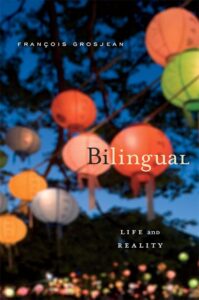 Bilingual: Life and Reality by Francois Grosjean is not exclusively focused on bilingual parenting. It also includes bilingual education. So compared to other bilingual parenting books, it casts a wider net and takes a slightly more academic approach to the topic of bilingualism.
Bilingual: Life and Reality by Francois Grosjean is not exclusively focused on bilingual parenting. It also includes bilingual education. So compared to other bilingual parenting books, it casts a wider net and takes a slightly more academic approach to the topic of bilingualism.
Grosjean writes in a clear way and sprinkles in personal anecdotes and examples to illustrate his points. He unravels myths and misconceptions, connecting research findings with real life examples. He looks at a number of different bilinguals from the child who acquires two languages from birth to adults who learn an additional language.
Personally, I very much liked the first chapter of the book: Who is a bilingual? Right from the very beginning, Grosjean makes the important point that ‘a bilingual’ is not the sum of two monolingual speakers. He highlights that there are different degrees of bilingualism because we use our languages for different purposes and in different contexts. As an ambitious parent, you may find that chapter helpful because it puts bilingualism into perspective. In other words, it’s totally normal if your child is stronger in one of her languages.
Overall, it’s a great read for parents who are interested in a somewhat deeper dive into the topic of bilingualism.
Bilingual Children: A Guide for Parents (Meisel)
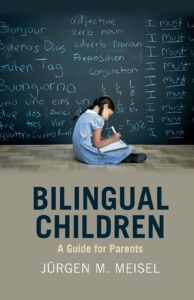 Meisel’s 2019 book Bilingual children: A Guide for Parents is an interesting read for parents who already have substantial knowledge about bilingualism and know how to deal with multiple languages at home. The book is written in a fairly academic language. It discusses topics such as myths and misconceptions about bilingualism, benefits of being bilingual, how language develops in children, and how languages interact (e.g., code-switching in children and how parents’ language choices impacts the mixing of languages). It provides a thorough discussion of language dominance (the fact that one language tends to be stronger in bilinguals) and trilingualism. The chapter dedicated to trilingual families is unique because this topic is rarely addressed in such detail in other overview books (there are specific books though that deal with trilingualism such as Language Strategies for Trilingual Families: Parents’ Perspectives).
Meisel’s 2019 book Bilingual children: A Guide for Parents is an interesting read for parents who already have substantial knowledge about bilingualism and know how to deal with multiple languages at home. The book is written in a fairly academic language. It discusses topics such as myths and misconceptions about bilingualism, benefits of being bilingual, how language develops in children, and how languages interact (e.g., code-switching in children and how parents’ language choices impacts the mixing of languages). It provides a thorough discussion of language dominance (the fact that one language tends to be stronger in bilinguals) and trilingualism. The chapter dedicated to trilingual families is unique because this topic is rarely addressed in such detail in other overview books (there are specific books though that deal with trilingualism such as Language Strategies for Trilingual Families: Parents’ Perspectives).
Overall, I would recommend this book to parents who have a more thorough interest in the topic of bilingualism and want to further advance their knowledge and understanding about child bilingualism.
The Psycholinguistics of Bilingualism
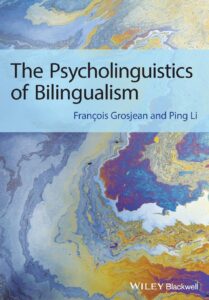 The Psycholinguistics of Bilingualism was written by two renown academics in the area of bilingualism and psychology: Francois Grosjean, a Professor Emeritus of Psycholinguistics, and Ping Li, a Professor of Psychology, Linguistics and Information Sciences. Additionally, the book features contributions from other well-known experts, including Ellen Bialystok.
The Psycholinguistics of Bilingualism was written by two renown academics in the area of bilingualism and psychology: Francois Grosjean, a Professor Emeritus of Psycholinguistics, and Ping Li, a Professor of Psychology, Linguistics and Information Sciences. Additionally, the book features contributions from other well-known experts, including Ellen Bialystok.
The book begins with a short introduction to bilingualism and biculturalism. It introduces aspects like language dominance and what it means to be bilingual (beyond just speaking two languages). Then it features four main sections: (1) Spoken language processing (listening and speaking), (2) Written language processing (reading and writing), (3) Language acquisition and (4) Cognition and the bilingual brain. The first two sections that focus on the four skills–listening, speaking, reading, and writing–offer summaries of relevant research studies. For example, the chapter on listening discusses how bilinguals process language when they speak with other bilinguals or monolinguals, respectively. Section (3) which deals with language acquisition is divided into a part on simultaneous bilingualism (learning multiple languages from birth) and successive bilingualism (learning additional languages later on in life). It outlines theories of language acquisition and how different languages influence one another. The last section deals with cognition and the bilingual brain. Here the authors discuss in detail how the bilingual memory works.
Overall, the book deals with bilinguals in general, with adults and children. It covers simultaneous bilingualism and successive bilingualism. It is written for an academic audience. For instance, each chapter features further readings and research questions. If you are okay with a more academic read, technical vocabulary, and advanced aspects of bilingualism, then this book is a good read that provides a very interesting psycholinguistic perspective on bilingualism.
Many thanks for reading!
Do you have other book recommendations?
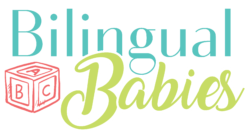
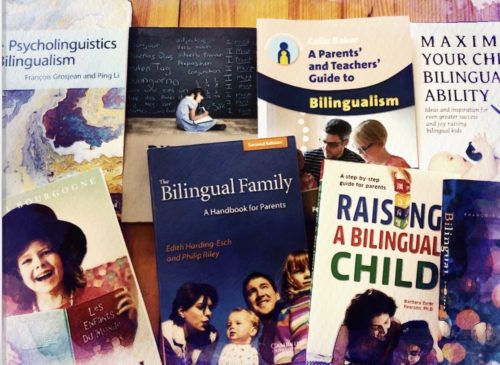
1 comment
Hello! Thank you for this great collection. Could I suggest 2 other books?
“The Toolbox for Multilingual Families” by Ana-Elisa Miranda and Dr Ute Limacher-Riebold
“The Parents’ Guide to Raising Multi-literate Children” by Yoshito Darmon-Shimamori (I’m the author)
They are both books offering a wide collection of activities. They are both available on Amazon.